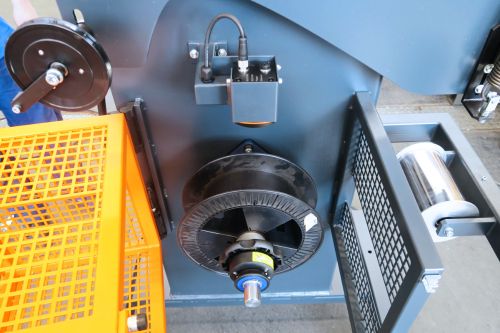Mobac – Stopping when the end is near
Reflection trick of O3D sensor solves rewinder application
Mobac GmbH specialises in wire and cable pay-out systems. In keeping with the motto of leading wire and cable manufacturers “If you want to produce wires and cables, you should be able to brake”, Mobac devotes special attention to the perfect braking point of their machines. The reason: If the rapid unwinding process is not stopped before reaching the wire end, the wire attached to the bobbin will inevitably destroy the winding mechanics and spools. To prevent this, Mobac uses a camera sensor from ifm, which reliably detects the last material layer on the bobbin and triggers a braking event in time.
Michael Will, Technical Manager at Mobac: “We build winding, unwinding and rewinding machines for all types of materials. Originally at home in the classical wire and cable industry, we also wind film, extruder products, ropes or even fibres, such as carbon fibres, today. Basically every material that is wound and unwound in some way and must be versatile and flexible to use.”
Welding wire rewinding
One of Mobac’s custom-built machines is a rewinder for processing different types of welding wires. The machine distributes the welding wire from a large supply spool to many small customer-specific spools.
Michael Will describes the problem: “Our customer’s request was to automatically stop the rewinding process before the wire end on the supply spool is reached. Usually, the wire end is firmly attached to the supply spool. If the unwinding process reaches the wire end at high speed, the spools or other components in the rewinding station will be destroyed as welding wires have fairly high tensile strengths.
In the past, an operator watched the supply spool and manually stopped the process in time. The operator then unwound the remaining windings on the spool in manual jog mode or simply cut off the end and threw it away. This was neither safe or efficient. The challenge was to develop an unwinder that approaches the wire end at high speed and automatically recognises when the last layer on the supply spool is starting to unwind.”
The sensor brakes
Searching for a solution, Mobac turned to automation specialist ifm. The requirement: a sensor that detects the last winding on the supply spool and causes the rewinder to break gently, but in time.
Having tested different types of photoelectric sensors to detect the wire end on various bobbins, the photoelectric O3D sensor from ifm proved to be the most reliable and universal solution for Mobac’s application. Originally developed for 3D detection of objects and scenes, a completely different feature of this sensor is used in Mobac’s application.

Pay-off unit incorporating different types of spools
Reflectance values and ROIs
Stefan Leimann, Senior Sales Engineer Position Sensors at ifm, explains the trick: “For each pixel of the camera image, the sensor provides a reflectance value, which we use. In the sensor, it is represented as an amplitude value of 0...65,536. When the sensor looks at the wire, it sees a bright white line. This is the light reflected from the wire. It creates a very high amplitude value. If the value falls below a defined threshold, it indicates reduced reflectance. This is exactly what happens when there is no more wire present.
In the camera sensor, we have defined two Regions of Interest (ROIs): the left and right sides of the spool. This means that it is irrelevant whether the last layer is unwound from the left or right side. As soon as one of the sensor’s two ROIs “looks” at the bobbin, the reflectance value will drop. A sensor signal will cause the unwinding process to stop right before reaching the last winding, which is attached to the bobbin. This reliably prevents damage to the machine.”
Maximum flexibility
A challenge that had to be solved: The supply spools consist of different carrier types. Sometimes they are plastic spools consisting of what is known as a solid body, sometimes they are welding wire spools made of wire mesh. In addition, there are different types of wire: blank wire or coated wire in various colours.
“Our customer processes wires with different diameters and carrier spools on this machine. Thanks to the universal parameter setting of the sensor, we don’t have to adjust the parameters even with different wire/spool combinations. The last layer is always reliably detected based on the reflectance value. This is why we chose ifm’s sensor. With it, we can cover the full range. Our customer is able to load any type of spool, even spools we haven’t tested on this machine beforehand,” said Michael Will.
Mobac intends to equip all future machines with this auto-stop function where required. “Our machines are built according to the customers’ requirements. The camera makes sense where no operators are present on site or where one operator manages several machines at the same time. In such cases, we offer our customers this sensor as an option.”

The empty bobbin reflects significantly less light than the wire. The sensor signals “No wire present”.
Bottom line
Sometimes you have to think outside the box. It may turn out that a sensor developed for a different purpose is your ideal problem solver. Michael Will is thrilled: “Compact, robust and easy to use, the O3D from ifm is perfectly suited for our application. A solution that meets all of our expectations. If only we had thought of it sooner. We could have saved ourselves a lot of time testing other sensors. For us, it was it interesting to see which use cases the sensor can cover.”